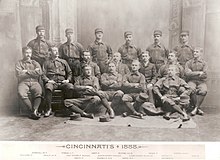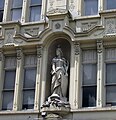|
Over-the-Rhine
 Over-the-Rhine, often abbreviated as OTR, is a residential neighborhood located in the urban basin of Cincinnati, Ohio. Over-the-Rhine is among the largest, most intact urban historic districts in the United States.[2] Originally settled by Ohio Rhinelanders (German: Ohio Rheinländer), the neighborhood became home to significant African-American and Appalachian populations during the mid-20th century.[3] It is home to several of Cincinnati's most famous landmarks, including Music Hall and Findlay Market. EtymologyThe neighborhood's name comes from Rhinelanders who settled the area in the mid-19th century.[4] Many walked to work across bridges over the Miami and Erie Canal, which separated the area from downtown Cincinnati. The canal was nicknamed "the Rhine" in reference to the river Rhine in Germany, and the newly settled area north of the canal as "Over the Rhine".[5][6] In German, the district was called über den Rhein.[citation needed] An early reference to the canal as "the Rhine" appears in the 1853 book White, Red, Black, in which traveler Ferenc Pulszky wrote, "The Germans live all together across the Miami Canal, which is, therefore, here jocosely called the 'Rhine.' "[7] In 1875 writer Daniel J. Kenny referred to the area exclusively as "Over the Rhine." He noted, "Germans and Americans alike love to call the district 'Over the Rhine.' "[8] Eventually, the canal was drained and capped by Central Parkway; the resulting tunnel was to be used for the now-defunct Cincinnati Subway project.[citation needed] HistoryBuilt in the nineteenth century during a period of extensive German immigration, first settled by Pennsylvania Dutch and bolstered by Rhinelanders and other Germans, Over-the-Rhine began to change demographically as residents moved to the suburbs following World War II.[9] The city and area had lost many of the industrial jobs that once supported its workers. By the end of the century, the area was noted for its poverty. Residents united and created many life-saving organizations.[5] Following social unrest in 2001, the neighborhood has since been the focus of millions of dollars of redevelopment.[10] Geography Over-the-Rhine, one of the largest, most intact urban historic districts in the United States,[2] has several districts. The Northern Liberties[11] and the Brewery District[12] are north of Liberty Street. South of Liberty are the Gateway Quarter and Pendleton.[citation needed] The Washington Park AreaIn recent years, developers have renamed this portion of Over-the-Rhine as "The Gateway Quarter". This area has been the focal point of gentrification, which has displaced African Americans and low-income residents. More than 1,000 African Americans left this area between 2000 and 2010, and by 2012 it had become a predominantly white, wealthy and exclusive section of the neighborhood.[13] The Brewery DistrictNorth of Liberty Street sat the heart of Cincinnati's beer brewing industry.[14] Christian Moerlein established his first brewing company in Over-the-Rhine in 1853. Eventually the Christian Moerlein Brewing Co. became the city's largest brewery and expanded into the national market. At its height the brewery occupied three entire city blocks. Prohibition brought an end to the company in the 1920s.[15] In 2010 the revived Christian Moerlein Brewing Co. began brewing beer in the Brewery District once again.[16] North of Liberty StreetThis area of the neighborhood has been relatively untouched by recent "gentrification efforts" and may resemble 1990s OTR better than other areas.[17] In the late 1820s, English writer Fanny Trollope, mother of Anthony Trollope, lived in the Mohawk area, which today is considered part of Over-the-Rhine.[18] The acerbic portrayal of Americans of that period in her book Domestic Manners of the Americans is based in part on her interactions with the rough-hewn residents of the area.[citation needed] Until 1849, today's Liberty Street, then called Northern Row, was the corporation line forming Cincinnati's northern boundary. The area north of Northern Row was not subject to municipal law and was called "The Northern Liberties". In 1955, the city decided to widen Liberty Street to connect with Reading Road as an east-west crosstown access point for the interstate highway system. Buildings on the south side of the street were demolished and the street was widened from two to five lanes. As of 2019, efforts are underway to narrow Liberty Street to bridge the gap between these halves of the neighborhood.[19] RevitalizationOver-the-Rhine Neighborhood RevitalizationOver-the-Rhine, the site of the 2001 Cincinnati riots, became the city's most dangerous neighborhood by 2009. However, it has since seen intensive redevelopment efforts.[10] Private development corporations and city officials have begun to address the problems that come with a neighborhood with low employment and high crime rates. A neo-liberal urban renewal strategy encourages private corporations rather than the city government to take on renewing and updating this area.[20] Cincinnati Center City Development CorporationThe Cincinnati Center City Development Corporation (3CDC) is a private, non-profit real-estate development and finance organization focused on revitalizing Cincinnati's urban core with the city government and local corporations. Its work is focused on the central business district and in the Over-the-Rhine neighborhood. The organization is widely credited with revitalizing OTR.[10] The organization began as a full-service real estate developer, but has since branched out and produces more than 1,000 events per year[21] at the four civic spaces it manages: Fountain Square, Washington Park, Ziegler Park and Memorial Hall.[citation needed] In July 2003, 3CDC was formed by former mayor of Cincinnati Charlie Luken and other corporate community members. This was a result of a recommendation by a City of Cincinnati Economic Development Task Force. Most funds are gathered through corporate contributions. In 2004, 3CDC accepted responsibility for overseeing Cincinnati New Markets Fund and Cincinnati Equity Fund. As of May 2018, those funds total over $250 million and have resulted in over $1.3 billion[22] invested in downtown and Over-the-Rhine real estate projects.[citation needed] ArchitectureOver-the-Rhine has been praised for its collection of historic architecture. The New York Times described the neighborhood as having "a scale and grace reminiscent of Greenwich Village in New York."[23] Its architectural significance has also been compared to the French Quarter in New Orleans and the historic districts of Savannah, Georgia and Charleston, South Carolina.[23][24] When Arthur Frommer, founder of the Frommer's travel guides, visited Over-the-Rhine he described it as the most promising urban area for revitalization in the United States, and claimed that its potential for tourism "literally could rival similar prosperous and heavily visited areas."[25][26] Most of Over-the-Rhine's ornate brick buildings were built by German immigrants from 1865 to the 1880s.[23] The architecture of Over-the-Rhine reflects the diverse styles of the late nineteenth century—simple vernacular, muted Greek Revival, Italianate and Queen Anne.[27] Most of the buildings in Over-the-Rhine are one of these styles, but other motifs include the Art Deco American Building on Central Parkway; the Germania Building at Twelfth and Walnut streets, ironically one of the few examples of German ornamentation in the neighborhood; Music Hall, a mixture of styles best described as Venetian Gothic; a handful of buildings with Gothic architecture; and the new SCPA on Central Parkway, the most notable example of Modern architecture in the neighborhood.[2]
New constructionNoted Indianapolis architect Evans Woollen III and his architectural firm of Woollen, Molzan and Partners helped redevelop the historic neighborhood in the 1970s and 1980s. Woollen designed the Over-the-Rhine Pilot Center (1972–84), a group of four modern, mixed-use buildings within a two-block area.[28] The Pilot Center buildings included a recreational center, a senior citizens center, a Montessori school and daycare center, and a meeting and event space. Funding for the $2.5 million project came from the U.S. Department of Housing and Urban Development.[29] Historic restoration In 2011 the Over-the-Rhine Foundation, which works to prevent historic building loss in OTR, won third place in the National Trust for Historic Preservation's nationwide "This Place Matters" community challenge.[30] In 2006 the National Trust for Historic Preservation listed the status of Over-the-Rhine as "Endangered."[27] Since 1930, about half of Over-the-Rhine's historic buildings have been destroyed.[25] More will follow unless deteriorating buildings are repaired.[27] Between 2001 and 2006, the city approved more than 50 "emergency demolitions," which were caused by absentee landlords' allowing their buildings to become so critically dilapidated that the city declared them a danger to the public. Reinvestment could have saved them.[25][31] Due to the situation, the National Trust for Historic Preservation declared Over-the-Rhine one of Eleven Most Endangered Historic Places in 2006.[27] Over-the-Rhine was included in the 2008 book, Frommer's 500 Places to See Before They Disappear, which noted the district's "shocking state of neglect".[32] According to WCPO in 2001, some of the worst-kept properties at the time were owned by Over-the-Rhine's non-profits,[33] which let the buildings sit vacant and deteriorating because of lack of funds[34] or volunteers.[35] With some buildings on the verge of collapse, investors and real-estate developers are trying to restore them before deterioration to the point of requiring demolition.[23] According to the U.S. Census Bureau in 2010, part of Over-the-Rhine had one of the highest rates of abandoned and vacant homes in the country. They classified it then as the sixth hardest area in the nation to get an accurate population count.[36] In recent years there has been a burst of restoration and development slowly moving northward year by year from Central Parkway, with a focus on attracting local small businesses rather than national chains.[10] Developers have restored and renovated the abandoned buildings, the city renovated nearby Washington Park, and businesses and residents have moved into what were abandoned spaces. Local chefs and artisan brewers in particular embraced the area, and in 2018 Food & Wine Magazine called it "one of the country's most promising food scenes."[37] Demographics
In 2001 there were an estimated 500 vacant buildings in Over-the-Rhine with 2,500 residential units.[17] Of those residential units 278 were condemned as uninhabitable.[17] Also in 2001 the owner-occupancy rate was between 3 and 4 percent compared to the citywide rate of 39 percent.[17] According to the "Drilldown", a comprehensive analysis of the city's actual population and demographics conducted in 2007, OTR's current population was just 4,970.[43] At the 2000 census,[44] the racial makeup of Over-the-Rhine was 19.4% White, 76.9% African American, and less than 4% of other races. 0.6% of the population were Hispanics or Latinos of any race.[45] The neighborhood's residents comprise roughly 1.2% of the population of the City of Cincinnati.[citation needed] Recent gentrification has changed the demographic makeup of the area as residents moving in tend to have a higher income and are more likely to be white.[46] By 2018 the website statisticalatlas.com was estimating OTR's population to be 34% white and 54% black, with 56% of those between the ages of 20 and 24 being white.[47] In media
List of annual eventsA partial list of Over-the-Rhine’s distinctive annual events includes:
List of landmarksMost of Over-the-Rhine's landmarks are related to the arts and are clustered in one area near Downtown. 
List of historic churches
Notable people
References
External linksWikimedia Commons has media related to Over-the-Rhine, Cincinnati. |
||||||||||||||||||||||||||||||||||||||||||||||||||||||||||||||||||||||||||||||||||||||||||||||||||||||||||||||||||||||||||||||||














